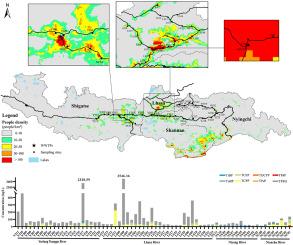青藏高原雅鲁藏布江及其主要支流有机磷酯的赋存、空间分布、来源及潜在风险
IF 7.3
2区 环境科学与生态学
Q1 ENVIRONMENTAL SCIENCES
引用次数: 0
摘要
有机磷酸酯(OPEs)作为阻燃剂和增塑剂广泛应用于各种产品中。由于OPEs的高溶解度、流动性和持久性,在相对高浓度的水生环境中经常检测到OPEs,并可能对生态系统和人类健康构成风险。研究了雅鲁藏布江及其主要支流拉萨河、年楚河和尼阳河夏季8种OPE同族植物的发生、空间分布、影响因素、来源及潜在风险。虽然检测到所有的OPE同系物,但单个OPE的检测频率从10.3% (TPeP)到100% (TPPO)不等。∑8OPEs的浓度范围为15.1 ~ 2.55 × 103 ng/L,单个OPEs的浓度范围为低于方法检出限的2.51 × 103 ng/L,其中TPPO、TCEP和TCPP为主要同源物。在4条河流中,靠近人口密集区的采样点∑8OPE浓度高于远离人口密集区的采样点。拉萨河∑8OPE浓度也高于尼阳河。当地的人为活动、污水处理厂以及温度、pH和盐度等水文特征可能是影响OPE分布的主要因素。来源指定表明,三种卤化OPEs可能具有相似的来源,而TPPO的来源可能更为复杂。河流中有机磷农药的生态和健康风险处于可接受水平。但YJ17和LS08的TPPO对水生生物构成中度生态风险,应引起重视。本文章由计算机程序翻译,如有差异,请以英文原文为准。


Occurrence, spatial distributions, sources, and potential risks of organophosphate esters in Yarlung Tsangpo River and its main tributaries on the Tibetan Plateau
Organophosphate esters (OPEs) are extensively utilized as flame retardants and plasticizers in a wide range of products. Because of their high solubility, mobility, and persistence, OPEs are frequently detected in aquatic environments with relatively high concentrations and may pose risks to the ecosystem and human health. In the present study, the occurrence, spatial distributions, influencing factors, sources, and potential risks of eight OPE congeners in the Yarlung Tsangpo River and its main tributaries (the Lhasa, Nianchu, and Niyang Rivers) in the summer were investigated. Although all of the OPE congeners were detected, the detection frequencies of the individual OPEs varied from 10.3 % (TPeP) to 100 % (TPPO). The concentrations of the ∑8OPEs ranged from 15.1 to 2.55 × 103 ng/L while those of the individual OPEs ranged from below the method detection limit to 2.51 × 103 ng/L, with TPPO, TCEP, and TCPP being the main congeners. In all the four rivers, sampling sites near to the more populated regions had higher ∑8OPE concentrations than those farther away. The Lhasa River also presented higher ∑8OPE concentrations than the Niyang River. Local anthropogenic activities, wastewater treatment plants, and hydrological features such as temperature, pH, and salinity might be the main factors influencing OPE distribution. Source appointment of the OPEs indicated that the three halogenated OPEs might share similar sources, whereas the sources of TPPO might be more complex. The ecological and health risks of the OPEs in the rivers were at acceptable levels. However, TPPO at YJ17 and LS08 would pose a moderate ecological risk to the aquatic organisms, indicating that more attention should be paid to it at these sites.
求助全文
通过发布文献求助,成功后即可免费获取论文全文。
去求助
来源期刊

Environmental Pollution
环境科学-环境科学
CiteScore
16.00
自引率
6.70%
发文量
2082
审稿时长
2.9 months
期刊介绍:
Environmental Pollution is an international peer-reviewed journal that publishes high-quality research papers and review articles covering all aspects of environmental pollution and its impacts on ecosystems and human health.
Subject areas include, but are not limited to:
• Sources and occurrences of pollutants that are clearly defined and measured in environmental compartments, food and food-related items, and human bodies;
• Interlinks between contaminant exposure and biological, ecological, and human health effects, including those of climate change;
• Contaminants of emerging concerns (including but not limited to antibiotic resistant microorganisms or genes, microplastics/nanoplastics, electronic wastes, light, and noise) and/or their biological, ecological, or human health effects;
• Laboratory and field studies on the remediation/mitigation of environmental pollution via new techniques and with clear links to biological, ecological, or human health effects;
• Modeling of pollution processes, patterns, or trends that is of clear environmental and/or human health interest;
• New techniques that measure and examine environmental occurrences, transport, behavior, and effects of pollutants within the environment or the laboratory, provided that they can be clearly used to address problems within regional or global environmental compartments.
 求助内容:
求助内容: 应助结果提醒方式:
应助结果提醒方式:


